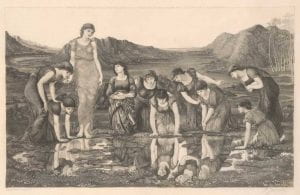The Mirror of Venus, in Print

If this engraving appears familiar, albeit here in less colourful tones, that is due to it being a reproduction of Pre-Raphaelite artist Edward Burne-Jones’ painting of the same name from 1877. Far from a case of egregious artistic plagiarism, from the 17th-century onwards it was commonplace for engravings to be created based on popular paintings. As today one might visit an exhibit at a gallery and purchase a poster in the gift shop in lieu of owning a priceless original painting itself, reproductions made in print allowed a larger and more wide-spread audience to access and own works of art. Inscriptions in Latin on the edge of an engraving spoke to who had what role in the production of a print; an artist invenit (invented) the work, before an engraver sculpsit (engraved) the plate, and a publisher divulgavit (published) and distributed it (195).
While there is comparatively little recorded about the engraver Jasinki, Burne-Jones was a prominent figure in the popular Pre-Raphaelite art movement. Founded in the mid-19th century, the “Brotherhood” as they were known were committed to expressing vivid colours, true emotion, and wild nature in their work, in contrast to the rigid classical perfection of for example, the artist Raphael’s High Renaissance art. The Brotherhood often turned to ancient and medieval myths for their inspiration, a nostalgia shared with the rising medievalism movement being created parallel to them. Print-maker and calligrapher William Morris developed the Kelmscott Press to produce books which he believed were equal in beauty and quality to medieval early printed books; a set is held in the international collections of Rare Books. By 1877 when this painting was created, Burne-Jones had become associated with another corresponding artistic trend known as Aestheticism, which aimed for ideal beauty rather than a deeper meaning or narrative. In The Mirror of Venus, handsome auburn-haired women in a non-descript landscape setting examine their own beauty, seemingly with no purpose other than to appreciate the aesthetic ideal which they embody. Venus herself, distinguishable from the other women by her blonde hair and upright position, has her own reflection obscured by lily pads. Despite being the Goddess of Beauty and Love, she is not lost in her own image; here Burne-Jones does add a complexity to his work, and what is being represented regarding the relationship between beauty and love, and whether complete fixation on one leaves space for the other. In any case, the viewer of this painting is left reflecting on the nature of beauty, as do the women gazing into Venus’ mirror.
The use of vellum for Jasinki’s print adds a soft creaminess to the light sections of the engraving; the lines of black ink are neither harsh nor rigidly mathematical in their curvature, which adds to the general dream-like feeling of the work. Even without the multitude of colours seen in the original painting’s dresses and flowery surroundings, the print exudes an arresting loveliness, speaking to the work’s preoccupation with idyllic aesthetics. While the original Burne-Jones’ painting is far away in Lisbon’s Calouste Gulbenkian Museum, it is inspiring to have such a faithful and contemporary reproduction as part of the Baillieu’s Print Collection.
Adelaide Greig.
Print Room Intern.
Further reading
Ward, Gerald W. R., editor. The Grove Encyclopaedia of Materials and Techniques in Art, (Oxford: Oxford University Press), 2008.
Delahunty, Andrew and Dignen, Sheila, editors. A Dictionary of Reference and Allusion, (Oxford: Oxford University Press), 2010.
Categories
Leave a Reply